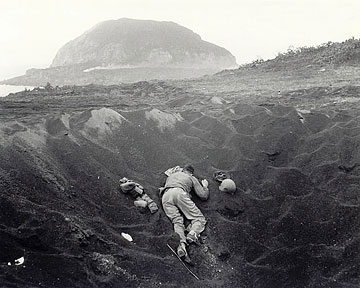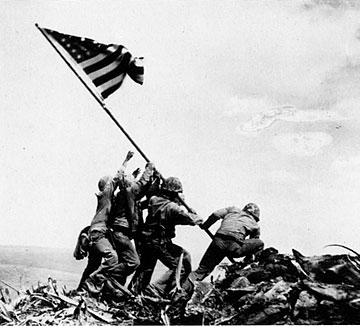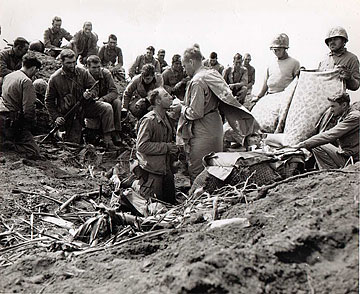FOR THEIR SERVICE

COURTESY U.S. MARINE CORPS
A Marine rifleman lies dead in an Iwo Jima shell hole, with Mt. Suribachi in the background. CLICK FOR LARGE
|
|
Remembrance
The battle of Iwo Jima started in Hawaii, and decades later we need to remember the sacrifice of the U.S. Marines
By Alice Clark
Special to the Star-Bulletin
THE U.S. Marine Corps celebrated its 231st birthday on Friday. Yesterday was Veterans Day. Playing in movie theaters across the country is Clint Eastwood's extraordinary film of James Brady's memoir "Flags of Our Fathers," about the bloody battle for Iwo Jima. Next month is the 65th anniversary of the attack on Pearl Harbor. Last week, there was a peaceful transition of power in both houses of Congress.
And at this moment, American troops are still overseas fighting for these democratic ideals.
CONTACT PWMA
The Pacific War Memorial Association welcomes inquiries and donations. Here's how to get more information:
Address: P.O. Box 1761 Honolulu, Hawaii 96806
Phone: (808) 533-3759
Fax: (808) 533-3129
E-mail: Alice or Bee Clark at abclark@aloha.net, or Kerry Gershaneck at kgershan@campus.hpu.edu
Web site: www.pacificwar memorial.org
|
It's an appropriate time to reflect on their sacrifice, perhaps by visiting the Pacific War Memorial at the entrance to Marine Corps Base Hawaii, Kaneohe Bay. A recasting of the famous image of flag-raising atop Mt. Suribachi during the assault on Iwo Jima, the memorial was dedicated in 2002, a gift to the Marine Corps by the Pacific War Memorial Association.
THE PWMA, an educational nonprofit organization registered in Hawaii, conceived and completed construction of the monument using molds donated by the National Iwo Jima Survivors Association. This memorial is at home in Hawaii, since the 4th and 5th divisions trained for the Battle of Iwo Jima on Maui and the Big Island. "Flags of Our Fathers" has several scenes of Marines training in Hawaii, and the lives of Marine veterans and Hawaii residents have been intertwined ever since.
Following the Japanese Imperial Navy's attack on Pearl Harbor and other U.S. military sites on Oahu on Dec. 7, 1941, nearly all of the Pacific Basin was in enemy hands. As the months went by, more and more units moved into the Pacific from the mainland to fight, island by bloody island, to take the war to Japan's doorstep. Sites in Hawaii were selected where troops could return after fighting these battles, to recuperate, be reinforced and train.
WAIMEA -- as Kamuela was known in those days -- was a Big Island town of about 400 residents, many of whom were Japanese immigrants from Hiroshima. Richard Palmer Kaleioku Smart, then owner of the huge Parker Ranch on the Big Island, offered to lease 40,000 acres of the ranch to the Marines for training. The 2nd and 5th Marine Divisions would train there, while the 4th Marine Division trained on Maui. Marine Corps Air Station, Ewa, was home for Marine aviation units. Kauai also hosted Marine training.

JOE ROSENTHAL/ASSOCIATED PRESS
Five Marines and one Navy corpsman raised a flag on Mt. Suribachi. CLICK FOR LARGE
|
|
The 2nd Marine Division, survivors of the pioneering but bloody amphibious assault on the Tarawa Atoll in November, 1943, traveled to an unfinished camp located at Parker Ranch on the Big Island. While refitting and recuperating, the 2nd Division Marines completed work on the camp, soon to be called "Camp Tarawa" in their honor. In the spring of 1944, the 2nd Marine Division redeployed for action at Saipan and Tinian.
THE 4TH Marine Division, activated in August 1943 at Camp Pendleton, Calif., came to Maui in February 1944, after participating in the Battle at Roe- Namur in the Marshall Islands. The division's Marines formed a friendship with the people of Maui and became "Maui's own." Maui was a home away from home for members of the 4th Marine Division.
The division left Maui in mid-May 1944 to fight at Saipan and Tinian in the Mariana Islands, where it suffered almost 6,500 casualties. It returned to Hawaii in August to a warm welcome, trained for several months, and then left for extensive maneuvers in January 1945. The next time any of them would see Maui would be after the battle of Iwo Jima.
The division's responsibility on Iwo Jima was to capture the airfields from the Japanese forces that had sworn to fight to the death to defend them. In that battle, the division suffered more than 9,000 casualties. Infantry rifle companies had losses exceeding their original landing strength. At the end of the battle, the division survivors returned to a hero's welcome in Maui, where they would train for the assault on the Japanese home islands. Thankfully, that assault never came.
THE 5TH Marine Division arrived at Camp Tarawa during the summer and fall of 1944 to train for battle on an unnamed island; at that point, only the division's leaders and their superiors knew it was the isolated volcanic islet of Iwo Jima.
At Kamuela, a Camp Tarawa memorial created by the PWMA reads: "The division conducted rehearsals for the assault using the steep volcanic hills located on Parker Ranch, which simulated Iwo Jima's most significant military feature -- Mt. Suribachi. By January 1945, the 5th Marine Division had departed Camp Tarawa for Iwo Jima."

COURTESY U.S. MARINE CORPS
In the midst of battle, Marines paused during the long campaign on Iwo Jima for Sunday services. CLICK FOR LARGE
|
|
The men who raised the two U.S. flags on Iwo Jima on Feb. 23, 1945, on the fifth day of the battle, did not do so to make history; they raised it to inspire those who fought beside them and to honor those already fallen. They simply obeyed the orders of their battalion commander, Lt. Col. Chandler W. Johnson (CO, 2d Battalion, 28th Marines) to raise the first Stars and Stripes over Mt. Suribachi, and then to recover it for the battalion and replace it with a larger flag. Associated Press photographer Joe Rosenthal immortalized this moment in film and provided America its most recognizable image from that war. The story of this iconic image is the heart of the film "Flags of Our Fathers."
THOSE WHO saw the national ensign flying high atop Suribachi pushed on for another 31 days until total victory was achieved. After that long, grueling battle -- Feb. 19 to March 26, 1945 -- the 5th Division returned to Camp Tarawa to regroup and train for a planned assault on mainland Japan. It departed again, after Japan signed the armistice agreement, on Sept. 2, 1945, aboard the USS Missouri, at anchor in Tokyo Bay, for occupation duty at Kyushu. Japan had become a democracy.
On the grounds around the memorial in Kaneohe are bricks dedicated to Marines killed in Iraq. Such memorials are not only dedicated to the past, but also to the present and the future.
Alice Clark is director of the Pacific War Memorial Association.

